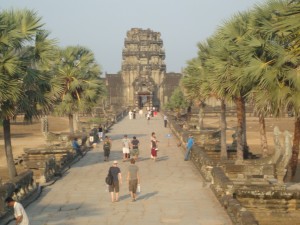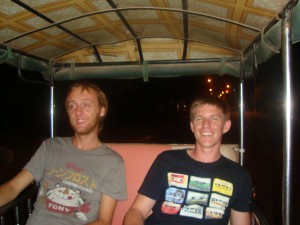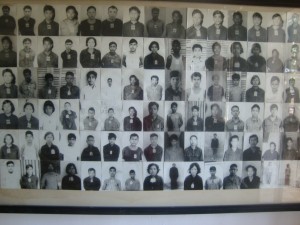If the Killing Fields and S-21 represent the low point of Khmer history, then the Temples of Angkor surely represent the pinnacle. Angkor, built largely in the 12th and 13th Centuries, is a city of mainly Hindu – with some Buddhist – temples which is so large you need a tuk-tuk to get around, and some people buy 5-day tickets just to fit it all in (although we think that may get a bit tedious!)
 We awoke at 4:30 in order to catch the sunrise at Angkor Wat, the biggest and most emblematic temple (in fact, the biggest religious building in the world). It was kind of spooky to be wandering round the ancient temple in the pre-dawn darkness, with the only light coming from the intermittent camera flashes of hordes of Japanese tourists. We were glad we got up early, however,when the sun finally rose over the three towers and most of the tourists went for breakfast, so we could wander round Angkor Wat in relative peace.
We awoke at 4:30 in order to catch the sunrise at Angkor Wat, the biggest and most emblematic temple (in fact, the biggest religious building in the world). It was kind of spooky to be wandering round the ancient temple in the pre-dawn darkness, with the only light coming from the intermittent camera flashes of hordes of Japanese tourists. We were glad we got up early, however,when the sun finally rose over the three towers and most of the tourists went for breakfast, so we could wander round Angkor Wat in relative peace.
The temple itself comprises the 3 symbolic towers surrounded by cloisters and corridors of adjoined ante-chambers, some filled with the fragrant smoke of jos sticks and ascetic monks preying to statues of Buddha (which is interesting because it was originally a Hindu temple). There was a huge garden surrounded by an outer wall and finally a gigantic moat, which must’ve been wider than the Thames at London.
We visited about 8 temples throughout the day, the noteworthy ones being Bupha – a temple of 316 sculpted heads and an amazing bas-relief scene depicting ancient Khmer life – and Tha Phrom, where large trees have grown through the temple itself. At the end of the day we climbed the highest temple to see the sun set, only to find it completely obscured by clouds! Ah well…
Words don’t really do the temples justice. Unfortunately neither can pictures because the battery ran out on our camera!
 Siem Reap itself is a fairly lively town. It’s very much geared towards tourism, but in a more palatable way than other cities we’ve visited; sparkling hotels are shouldered in with smaller, though no less clean, guest houses. We stayed in a lovely room with a hot shower and a TV for about 4 pounds a night. In fact, all the guest houses in Cambodia so far have been excellent, let’s see what Battambang brings!
Siem Reap itself is a fairly lively town. It’s very much geared towards tourism, but in a more palatable way than other cities we’ve visited; sparkling hotels are shouldered in with smaller, though no less clean, guest houses. We stayed in a lovely room with a hot shower and a TV for about 4 pounds a night. In fact, all the guest houses in Cambodia so far have been excellent, let’s see what Battambang brings!


